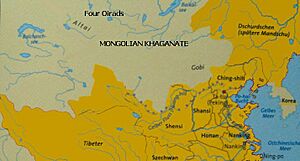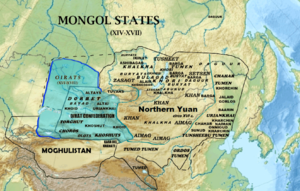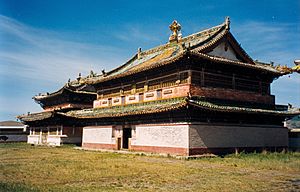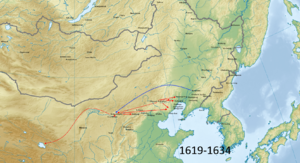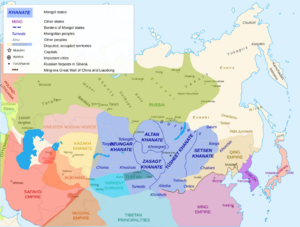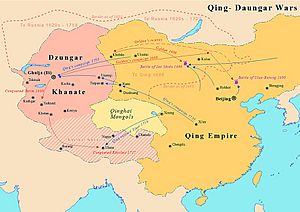Northern Yuan facts for kids
Quick facts for kids
Northern Yuan
北元 ᠳᠠᠢ
ᠦᠨ Dai Ön 大元 ("Great Yuan") ᠳᠥᠴᠢᠨ ᠳᠥᠷᠪᠡᠨ ᠮᠣᠩᠭᠣᠯ ᠤᠯᠤᠰ döčin dörben mongγol ulus ("Forty-four Mongol State") |
|||||||||||||||||
|---|---|---|---|---|---|---|---|---|---|---|---|---|---|---|---|---|---|
| 1368–1635 | |||||||||||||||||
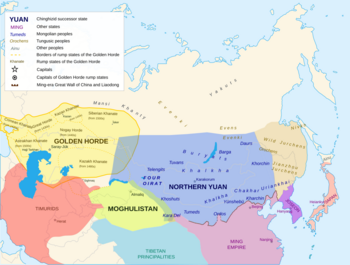
The Northern Yuan in the 15th century
|
|||||||||||||||||
| Capital |
|
||||||||||||||||
| Common languages | Mongolian, Chinese, Jurchen | ||||||||||||||||
| Religion | Tengrism, Buddhism, Islam | ||||||||||||||||
| Government | Monarchy | ||||||||||||||||
| Khagan | |||||||||||||||||
|
• 1368–1370
|
Ukhaghatu Khan Toghon Temür (first) | ||||||||||||||||
|
• 1370–1378
|
Biligtü Khan Ayushiridara | ||||||||||||||||
|
• 1378–1388
|
Uskhal Khan Tögüs Temür | ||||||||||||||||
| Legislature |
|
||||||||||||||||
| Historical era | Late Middle Ages | ||||||||||||||||
| September 1368 | |||||||||||||||||
|
• Death of Uskhal Khan Tögüs Temür
|
1388 | ||||||||||||||||
|
• Dayan Khan reunites the Mongol nation
|
1483–1510 | ||||||||||||||||
|
• Death of Ligdan Khan
|
1634 | ||||||||||||||||
|
• Ejei Khan submits to the Later Jin
|
1635 | ||||||||||||||||
| Currency | barter, Dirham | ||||||||||||||||
|
|||||||||||||||||
| Today part of | |||||||||||||||||
The Northern Yuan was a Mongol empire that ruled from the Mongolian Plateau. It started in 1368 after the Yuan dynasty collapsed. It lasted until 1635 when it was taken over by the Jurchen-led Later Jin dynasty. The Northern Yuan began when the Yuan court, led by Toghon Temür, moved to the Mongolian steppe. During this time, different groups fought for power. The role of the Great Khan was often just a title.
Dayan Khan and Mandukhai Khatun brought most Mongol tribes back together in the late 1400s. However, Dayan Khan divided his empire among his sons. This caused the central government to become weaker. Even so, the Mongol leaders generally got along. There were no major civil wars until the time of Ligdan Khan (1604–1634). His power weakened because of arguments with other Mongol tribes. He was eventually defeated by the Later Jin dynasty. In the last 60 years of this period, Tibetan Buddhism became very popular in Mongol society.
What's in a Name?
The empire that existed from 1368 to 1635 is known by several names. The most common is the Northern Yuan. The official name was "Great Yuan" (Dà Yuán). This name was used from 1368 to 1388, just like the earlier Yuan dynasty.
After Uskhal Khan Tögüs Temür died, his successor stopped using the "Great Yuan" name. So, sometimes "Northern Yuan" refers only to the period from 1368 to 1388. The name "Northern Yuan" comes from Chinese history books. The word "Northern" helps tell it apart from the Yuan dynasty that ruled China before 1368.
In English, "Northern Yuan" usually covers the whole period from 1368 to 1635. The Mongols themselves called their empire "Ikh Mongol Uls," which means "Great Mongol State." Some modern books also call it "Post-Imperial Mongolia" or the "Mongolian Khaganate."
In Mongolian history, this time is also known as "The Forty and the Four." This refers to the forty tümen (groups of ten thousand) of Eastern Mongols and four tümen of Western Mongols. Chinese historians from the Ming Dynasty called them "Tatar" and "Wala" (Oirats) after the Mongols split into eastern and western parts.
History of the Northern Yuan
How it Began
The Northern Yuan dynasty was what was left of the Yuan dynasty. The Yuan dynasty was founded by Kublai Khan and ruled all of China for about 100 years. Even before the Yuan dynasty, the Mongols had ruled northern China for over 40 years. They had conquered the Jurchen-led Jin dynasty in 1234.
The Yuan dynasty's rule in China began to fall apart in 1344. The Yellow River flooded and changed its path. This caused droughts and made the Grand Canal unusable. In 1351, the Red Turban Rebellion started. This rebellion led to the rise of Zhu Yuanzhang, a Chinese peasant. He later started the Ming dynasty in southern China in 1368. In that same year, a Ming army marched on the Yuan capital, Dadu (now Beijing).
Retreat to the Steppe (1368–1388)
Toghon Temür, the last Yuan ruler, fled north to Shangdu when the Ming forces arrived. He tried to take Dadu back but failed. He died in Yingchang two years later in 1370. The Ming took Yingchang shortly after his death.
The Mongols then moved to Karakorum in the heart of Mongolia. They kept the name "Great Yuan," which is now called "Northern Yuan." In 1372, the Ming army chased the Mongols into the steppe. But the Ming were defeated by Biligtü Khan Ayushiridara and his general Köke Temür.
In 1380, the Ming attacked the Northern Yuan again and looted Karakorum. They took about 70,000 Mongol prisoners. In 1387, the Ming defeated the Uriankhai Mongols. The next year, they won a big victory against Uskhal Khan Tögüs Temür near Buir Lake. This defeat greatly weakened the Yuan's power. It allowed the Western Oirat Mongols to become very powerful in the Northern Yuan.
The Mongol rulers of the Northern Yuan still claimed to be the true emperors of China. They used the title "Emperor of the Great Yuan." This was to resist the Ming, who now truly ruled China. The Ming dynasty believed there could only be one true emperor chosen by Heaven. So, they did not see the Northern Yuan rulers as legitimate emperors of China.
Oirat Power (1388–1478)
In 1388, Jorightu Khan Yesüder became the Mongol ruler. He was supported by the Oirats. He stopped using the Chinese-style titles of the old Yuan dynasty. The next century saw many Mongol rulers who were just puppets. They were put on the throne by powerful warlords. This time is sometimes called the "period of small kings."
The Mongols split into three main groups: the Oirats in the west, the Uriankhai in the northeast, and the Khorchin in the middle. The Uriankhai surrendered to the Ming dynasty in the 1390s.
Mongol relations with the Ming dynasty were a mix of fighting and peaceful trade. The Ming dynasty often launched campaigns against the Mongols. In 1409, a Ming army was defeated by the Mongols. But the next year, the Yongle Emperor led an expedition and defeated them.
By 1422, the Mongols and Ming were fighting again. The Oirats became very strong. Their leader, Toghan, pushed other Mongol groups eastward.
Toghan's son, Esen Taishi, made the Oirats most powerful. He controlled the puppet khans. In 1449, he defeated a huge Ming army and captured the Zhengtong Emperor. This event is known as the Tumu Crisis. However, Esen could not take the Ming capital of Beijing. A peace deal was made, and the captured emperor returned home. After killing the rebellious Mongol rulers, Esen took the title of Yuan Emperor. This caused many Mongols to disagree with him. In 1455, revolts led to Esen's death. His death caused the Oirats to decline.
After Esen's death, different warlords fought for control. They put various Mongol khans on the throne. This period lasted until 1481.
Mongol Restoration (1479–1600)
Reuniting the Mongols
Manduulun Khan's young wife, Mandukhai, declared a seven-year-old boy named Batumongke as the new khan. Mandukhai worked hard to bring the different Mongol tribes back together. The new khan took the title Dayan, meaning "the whole" or "Great Yuan." Mandukhai and Dayan Khan defeated the Oirats and other Mongol leaders.
Dayan Khan finally defeated the southwestern Mongols in 1510. He also got rid of old Yuan court titles. From 1495, Dayan put pressure on the Ming dynasty. The Ming closed border trade and killed his messengers. Dayan invaded Ming land and took control of the Uriankhai Three Guards. These groups had previously submitted to the Ming.
Dayan Khan's armies raided the Ming dynasty in both the north and west. The Ming dynasty lost control of Kara Del. Dayan kept defeating the Ming in battles until he died in 1543. At its peak, Dayan's empire stretched from Siberia to the Yellow River. It went from Manchuria in the east to Central Asia in the west.
Dayan Khan reorganized the Mongols into six Eastern Mongol tümens (groups of ten thousand) and four Oirat tümens. This had a big impact on Mongol society. He gave the six Eastern Mongol tümens to his 11 sons. The four Oirat tümens were ruled by noble leaders. This created a system where power was spread out. It brought peace within the Mongols and helped them expand for a century.
Last Reunification
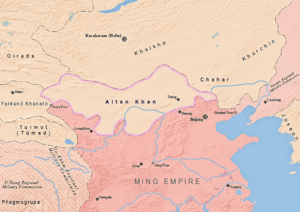
After Dayan Khan died, the Mongols started to split apart again. By 1540, new local leaders appeared in all of Dayan Khan's lands. The main khan had only a title over some groups. Darayisung Gödeng Khan had to give khan titles to his cousins, Altan Khan and Bayaskhul.
Under Tümen Jasagtu Khan, the empire was unified again. This was with the help of Altan Khan and other leaders. Jasagtu defeated the Uriankhai and Daghur Mongols. He also brought the Jurchens under his control. Altan and other leaders brought many Oirat tribes under their rule. Jasagtu also tried to unite the Mongols with a new set of laws.
Smallpox epidemics and a lack of trade forced the Mongols to raid China. In 1571, the Ming opened trade with some Mongol groups. By the end of the 1500s, the Uriankhai Three Guards no longer existed as a separate group.
Becoming Buddhist
Even though earlier Yuan emperors had adopted Buddhism, most Mongols still followed their traditional shamanist beliefs. From 1575, many Mongols in the Right Wing Tumens converted to Tibetan Buddhism. Jasagtu appointed a Buddhist chaplain. He agreed that Buddhism would become the official religion of Mongolia. In 1577, Altan and another leader met the 3rd Dalai Lama. This started the conversion of many Mongols to Buddhism. Soon after, the Oirats also adopted Buddhism. Many Tibetan lamas came to Mongolia to teach the religion.
The Fall of the Northern Yuan (1600–1635)
By the time of Ligdan Khan (1604–1634), the Eastern Mongol groups were no longer united. Ligdan only controlled his own group, the Chahar. The Khalkha and Oirat Mongols no longer listened to him. Ligdan built a new capital called Chaghan Baishin (White House). He also encouraged building Buddhist monasteries and trading with the Ming dynasty.
In 1616, the Jurchens became a powerful force in East Asia under Nurhaci. The Jurchens were not nomads like the Mongols. They were tribal people who had adopted Chinese farming practices. Nurhaci wanted to conquer the Ming dynasty. He looked for allies among the Khorchin Mongols, who were subjects of Ligdan. The princes of Khorchin and other southern Mongol groups made an alliance with the Jurchens from 1612 to 1624.
In response, Ligdan fought against the Mongol allies of the Jurchens in 1625. The Jurchen-Mongol army defeated Ligdan and forced him back. Many Jurchens and Mongols married each other, making their alliance stronger. Ligdan tried to control the other Mongol groups by force. In 1628, Ligdan defeated some Khorchins and Jurchens. But he fled from a large Jurchen army. Only one noble, Tsogt Taiji, supported Ligdan. Other Khalkha nobles stayed neutral.
In 1632, Hong Taiji of the Jurchens and his Mongol allies defeated the Chahars. They captured Ligdan's family. Ligdan lost all power over the non-Chahar Mongol groups. Ligdan died in 1634 while on his way to Qinghai. His son, Ejei Khan, surrendered to the Qing dynasty. He gave the Imperial Seal of the Mongols to the Qing emperor in 1635. This ended the rule of the Northern Yuan.
After Ligdan Khan's death in 1634, the Mongols formed four new Khanates:
- The Altan Khan of Khalkhas in the west.
- The Dzasagtu Khans.
- The Tushetu Khans near Ulaanbaatar.
- The Sechen Khans in eastern Mongolia.
What Happened Next
Outer Mongolia
By 1636, all of Inner Mongolia had been conquered by the Manchus. The Mongol Empire's successors were also under Manchu rule. Ligdan Khan's son, Ejei, died mysteriously. His title went to his brother Abunai, who refused to visit the Manchus' court. Abunai's title then went to his son, Burni. Burni rebelled against the Manchus in 1675, but his uprising was defeated. The Qing emperors then took direct control of the Chahar Mongols.
In Outer Mongolia, the Khalkhas still resisted Manchu rule. Tüsheet Khan Gombodorj kept his independence. However, another independent group, the Altan Khan of the Khalkha, appeared. With the loss of Inner Mongolia and the Imperial Mongol Seal, the Mongols needed a new source of authority. So, in 1639, Gombodorj's son became the first Jebtsundamba Khutuktu. This made him the spiritual leader of the Gelug Buddhists in Mongolia. Gombodorj tried to keep peace with the rising Manchus by sending them gifts. He also stopped giving horses to the Ming dynasty.
Diplomacy failed after the Manchus defeated the Ming in 1644 and took Beijing. In 1646, a Mongol noble rebelled against the Qing but was crushed. In 1647, Gombodorj fought the Qing with 50,000 cavalry. Neither side won a clear victory. But the Mongol army lost a larger part of its total forces than the Qing. This showed that the Mongols could no longer directly fight the Qing.
In the mid-1600s, Gombodorj died. His young son, Chikhundorj, took over. In 1655, the Qing began to interfere in Tusheet affairs. They appointed their own lamas in Tusheet territory. This way, Outer Mongolia slowly came under Qing control.
Dzungar Khanate
Meanwhile, in the west, the Oirats united under Kharkhul around 1600–1620. In 1635, the Oirats formed the Dzungar Khanate under Kharkhul's son, Erdeni Batur. This unity was partly because of their wars with the Altan Khans.
When the Jasagtu Khan Shira lost some of his people, Galdan Boshugtu Khan of the Dzungars moved his camp near the Altai Mountains. He prepared to attack. Chikhundorj attacked the Khalkhas and killed Shira in 1687. In 1688, Galdan sent troops against Chikhundorj, but they were defeated. Chikhundorj then killed another leader who was on his way to Galdan. To get revenge, Galdan made friends with the Russians. The Russians were already fighting Chikhundorj.
With Russian firearms, Galdan led 30,000 Dzungar troops into Outer Mongolia in 1688. He defeated Chikhundorj in three days. After two bloody battles, Chikhundorj and his brother fled to the Qing dynasty. They submitted to the Kangxi Emperor.
By 1690, Galdan controlled Outer Mongolia. He then turned his attention east towards Beijing. The Qing worried about the Dzungar state growing so large. The Kangxi Emperor blocked Galdan. In 1690, Galdan crossed the Kherlen River with 20,000 men. He fought a Qing army near the Liao River. Galdan was forced to retreat. He escaped complete defeat because the Qing army could not chase him.
In 1696, the Kangxi Emperor led 100,000 troops into Mongolia. Galdan fled but was caught by another Qing army. He was defeated in the Battle of Jao Modo. Galdan's wife, Anu, was killed. The Qing army captured many animals. Galdan fled with a few followers. He died in the Altai Mountains in 1697. Back in Dzungaria, his nephew, Tsewang Rabtan, was already in control. Outer Mongolia became part of the Qing Empire. The Khalkha leaders returned to Outer Mongolia as Qing subjects. The Qing forces took Hami. The Dzungars later expanded into Tibet and Kazakhstan. But they were also conquered by the Qing dynasty in 1755. All resistance ended by 1758.
See also
- List of khans of the Northern Yuan dynasty
- List of Mongol states
- Rump state




